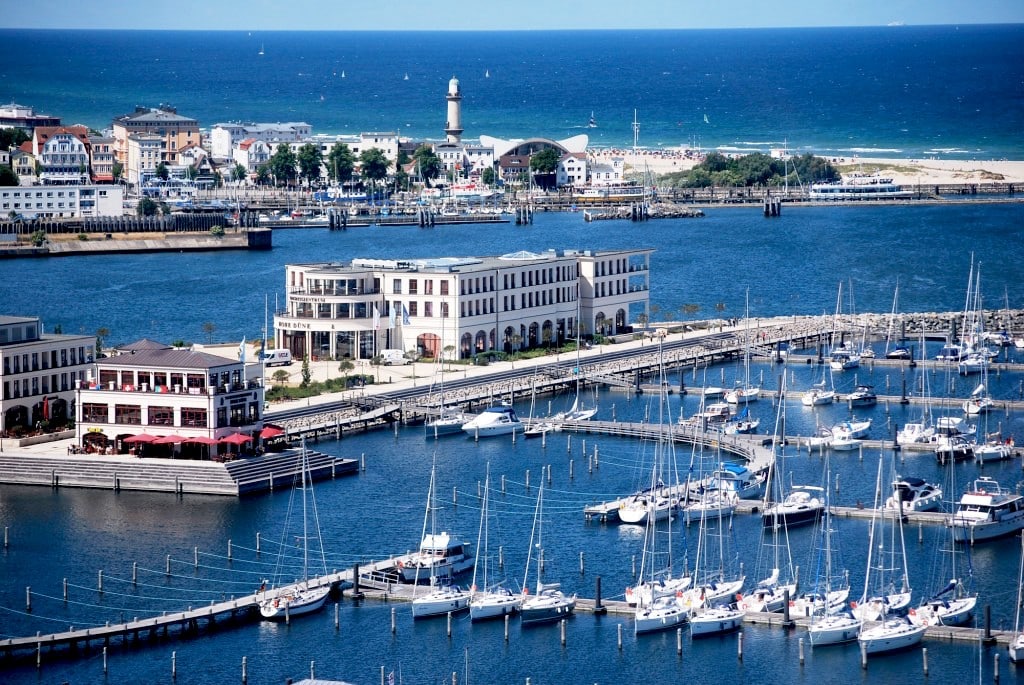
Marina in Rostock, Germany. (Beauwell, CC0, Wikimedia Commons)
Back in 2000, the television series “Andromeda” premiered, based upon unused material from Gene Roddenberry, the creator of the Star Trek series and franchise. The plot is premised on the notion of a spaceship, “Andromeda,” frozen in time, which is given the opportunity to reverse the clock and undo history.
The series ran five years.
Fast forward to the present.
History has dealt a tough hand to the administration of US President Joe Biden, who openly confessed his intent to “bring an end” to the Nord Stream pipeline system which delivered Russian natural gas to Europe through four pipelines (Nord Stream 1 and Nord Stream 2, consisting of two pipelines each).
Since then, the Biden White House was compelled to deny the president’s stated intent after an explosive report by Pulitzer-Prize winning investigative journalist Seymour Hersh detailed damning information which, if true (and there is no reason to suspect it’s not) casts the responsibility for a series of underwater explosions that took place on Sept. 26, 2022, on Biden himself.
Hersh’s report was ignored by the mainstream media in the United States, with neither The New York Times, for whom Seymour Hersh wrote on national security issues for many years, nor The Washington Post even hinting that the greatest living investigative journalist had broken a blockbuster story.
Enter the “Andromeda” — not the spaceship of the eponymous television series, but rather a Bavaria C50 15-meter (49-foot) yacht based out of the German Baltic port city of Rostock. On March 7 — nearly a month after Hersh self-published his article on Substack — a team of German reporters from the ARD capital studio, Kontraste, Südwestrundfunk (SWR) and Die Zeit collaboratively reported that they had uncovered the existence of “the boat that was allegedly used for the secret operation.”
The boat was “a yacht rented from a company based in Poland, apparently owned by two Ukrainians.” According to the story, “the secret operation at sea was carried out by a team of six people.”
The name of the yacht was “The Andromeda.”
According to the German reporting, the team — five men, consisting of a ship captain, two primary divers, two supporting divers and a female doctor — used the Andromeda to transport the team, along with the explosives used to destroy the pipelines, to the scene of the crime. The boat was returned to Rostock in “an uncleaned condition,” allowing German law enforcement officials, who carried out a search of the vessel between Jan. 8-11, to detect “traces of explosives” on a table in the ship’s cabin.
The same day the German reporting on the new Nord Stream attack narrative broke, The New York Times ran a front-page story entitled “Intelligence Suggests Pro-Ukrainian Group Sabotaged Pipelines, US Officials Say.”
For the first time, The New York Times referred to Hersh’s reporting, writing, “Last month, the investigative journalist Seymour Hersh published an article on the newsletter platform Substack concluding that the United States carried out the operation at the direction of Mr. Biden,” before closing with “US officials say Mr. Biden and his top aides did not authorize a mission to destroy the Nord Stream pipelines, and they say there was no US involvement.”
As if echoing the Biden White House denials, The New York Times led off with this:
New intelligence reporting amounts to the first significant known lead about who was responsible for the attack on the Nord Stream pipelines that carried natural gas from Russia to Europe (emphasis added.)
The New York Times, it seems, was more than happy about proceeding with its own anonymous intelligence sources, while dismissing Hersh’s.
The problem with both the German reporting and that of The New York Times (whose source was clearly referring to the same data reported by the German reporters) is that the Andromeda narrative doesn’t hold water.
Take, for instance, the Tom Clancy-like tale of derring-do that has four allegedly Ukraine-affiliated divers defy physiology by conducting dives that would require the use of a decompression chamber for them to survive an ascent of 240 feet (the depth of the Nord Stream pipelines that were destroyed). A rule of thumb is that decompression takes approximately one day per 100 feet of seawater plus a day.
This means that the team of divers would have required three days of decompression per dive. But to decompress, one needs a decompression chamber. For a dive involving two divers, the Andromeda would have to have been outfitted with either a two-person Class A decompression chamber, or two single-person Class B chambers, as well as the number of large oxygen bottles needed to operate these chambers over time.
A simple examination of the interior cabin space of the Bavarian C50 yacht would quickly dispossess one of any notion that either option was viable.
Simply put — no decompression chamber, no dive, no story.
‘Traces’ of High Explosives
There is another aspect of the story to probe. According to the German reporting, law enforcement officials detected “traces” of high explosives on the tables in the cabin of the Andromeda.
According to the Swedish Prosecution Authority, in a statement released on Nov. 19, 2022, Swedish investigators discovered “traces of explosives on several of the foreign objects that were found” at the site of the explosions.
These explosives, according to a Nov. 22, 2022, report issued by Nord Stream AG, the Swiss-based parent company that owned the Nord Stream 1 and 2 pipelines, produced “technogenic [i.e., “of or pertaining to a process or substance created by human technology”] craters with a depth of 3 to 5 meters” separated “by a distance of about 248 meters.”
“The section of the pipe between the craters is destroyed, the radius of pipe fragments dispersion is at least 250 meters,” the report noted.
In a report to the United Nations, both Denmark and Sweden said that the damage done to the Nord Stream pipelines was caused by blasts equivalent to the power of “several hundred kilograms of explosive.”
It should be noted that underwater pipelines like those used in Nord Stream are designed to withstand proximal explosions from devices up to several hundred kilograms in size. Indeed, in locations such as the Baltic Sea, where unexploded military ordnance from multiple world wars abounds, the threat of a drifting device striking a pipeline and detonating is quite real.
Computer modeling shows that a 600-kilogram high explosive charge detonated approximately 5 meters from a 34mm-thick steel pipeline filled with gas would not compromise the structural integrity of the pipeline.
A piece of Nord Stream pipe on public display in Kotka, Finland in 2017. (Vuo, CC BY-SA 4.0, Wikimedia Commons)
At the location of the explosions, the Nord Stream pipelines consisted of 26.8 mm steel pipes with an addition 33.2 mm of concrete coating, for a total thickness of 60 mm. The weight of a single pipe section was over 11 tons.
In short, a standard high-explosive charge of several hundred kilograms would not be sufficient to cause the destruction that occurred on the Nord Stream pipeline.
Enter Hersh, who reported that the explosives used were “shaped charges.”
With a shaped charge, the energy of the explosion is focused in one direction, usually by creating a concave shape in the explosive that is then lined with a metal sheet, so that it usually achieves an armor- and/or concrete-penetrating effect.
Without getting too technical, the design of an underwater shaped charge that would be sufficient to penetrate concrete-lined steel pipe at a depth of 240 feet is not common knowledge. The charge would have to be prepared by qualified explosives experts and ideally tested prior to being employed operationally to validate the design and functionality of the device.
These are not tasks undertaken by a small ad hoc team of Ukrainian underwater saboteurs, but rather state-sponsored actors with access to military grade explosives and testing facilities.
Strike two for the German reporting.
But the most glaring deficiency in the German reporting deals with the detection of “trace explosive” onboard the Andromeda. This information would identify the precise explosive used. Moreover, when compared and contrasted with the “trace explosive” found by the Swedes at the location of the Nord Stream attacks, it could provide a clear linkage between the Andromeda and the attacks.
But Sweden has sealed the files of its investigation into the Nord Stream attack on national security grounds, meaning that it will not cooperate with Germany to see if the explosive traces found at the scene of the Nord Stream crime match those onboard the Andromeda.
The obvious reason behind this decision: because the two traces won’t match. One — the Swedish sample — points to the culprit. The other — the Andromeda sample — is evidence of a cover up.
Strike three, and you’re out.
The German government’s crude effort to manufacture an alternative narrative regarding who attacked the Nord Stream pipeline fails the smell test — in short, it stinks. The holes in this story are such that even the most gifted screenwriters could not turn this Andromeda tale of changing history into something remotely believable. In short, Gene Roddenberry would not be impressed.
Moreover, the fact that the US intelligence community was quick to leak information about the German investigation to The New York Times appears to be de facto evidence of US complicity in this cover up.
And the reason for this cover up is quite clear: the Germans and Americans both fear the reporting being done by Hersh.
Reprinted with author’s permission from Consortium News.




